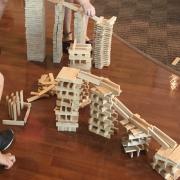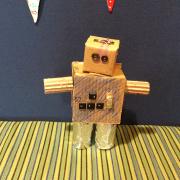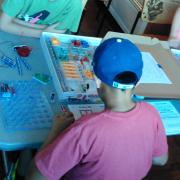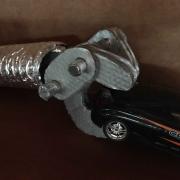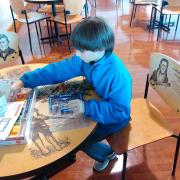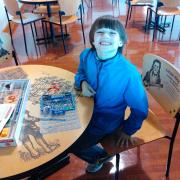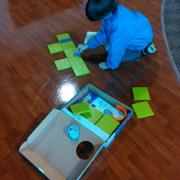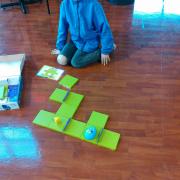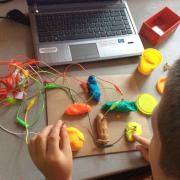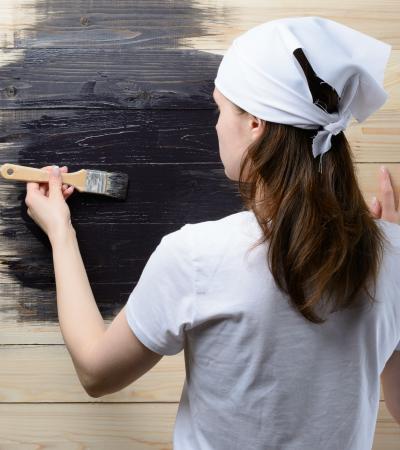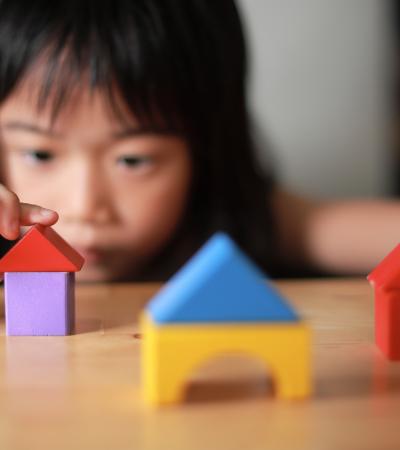Builder’s Club: Tween Edition is a hands-on, collaborative STEAM program for children ages 9 to 14. During each session, a library facilitator introduces a new topic for tweens to explore and practice.
Sessions include an architectural KEVA Plank lesson, an introduction to circuitry through Snap Circuits, an exploration of basic computer coding concepts in the Mouse Maze Challenge, a DIY video game controller class via Makey Makey, and a crash course in structural design through Cardboard Creations.
Advanced Planning
The Builder’s Clubs were part of our summer reading program grant, so nearly all of the programs were planned months in advance.
Before writing the grant request, I spoke with a few local teachers and asked about STEAM materials and technology to which their students had access. From there, I developed a multi-week program that targeted areas of need and interest (computer coding, technical skills, circuits, etc.) and that were centered on the summer reading program theme of Build a Better World.
The Builder’s Club programs were designed to introduce basic STEAM concepts to young people and provide opportunities for local kids to gain exposure to fun, new technology. Our goal was to purchase materials that could be used for future programming within the library and during classroom visits to area elementary and junior high schools.
We planned for two versions of the Builder’s Club: one for intergenerational hands-on learning and the other for targeted skill-building within the tween demographic. (We consider fourth- to eighth-graders tweens.) The Tween Edition required pre-registration and focused on one skill or concept each week, whereas the Family Edition was a drop-in, free-for-all play session.
Tween Builder’s Club took place from 4 to 5 p.m. on the second and fourth Thursdays of the month: June 8 (Keva Planks), June 22 (Snap Circuits), July 13 (Mouse Maze Challenge) and July 22 (Makey Makey). Due to popular demand, we added an additional program on August 10 (Cardboard Creations). Family Builder’s Club took place from 4 to 5 p.m. on first and third Thursdays.
Sign-up was for each individual week so kids could choose to attend programs that interested them, but we also accepted walk-ins if space allowed.
Marketing
We published all of the events in the library’s newsletter, which is distributed in print at the library and via email. We also posted general information on our Facebook page, but we did not create specific Facebook events. We have great attendance for our weekly performers targeting a younger demographic (150 to 200 kids per performer), but our sign-up-based programs for teens and tweens tend to be sparsely attended (2 to 15 kids per program).
Library staff members are encouraged to promote programs to our patrons, highlighting events depending on their target audience. Our summer reading program was promoted by a SJPL librarian, who described the fun materials we had purchased for the programs during classroom visits and assemblies.
We also have a giant dry-erase board that lists upcoming youth programs. Many parents take a picture of that signage with their phone while at the library, as opposed to grabbing a paper calendar or newsletter.
A majority of the attendees indicated that they found out about the program at the library, and the remaining attendees listed the library website or their parents as the source of referral.
Budgeting
Here is the cost breakdown of what we purchased through grant funding:
- One Snap Circuits SC300 Student Training Program ($80 on Amazon.com)
- four Snap Circuits SC300 Electronics Discovery Kit ($44 each on Amazon.com)
- five battery eliminators for Snap Circuits ($20 each on Amazon.com)
- Three LEGO Classic Large Creative Brick Box 10698 sets ($48 each on Amazon.com) with additional baseplates (4 six-packs of Building Bricks 10"x 10" Baseplates cost $23 each on Amazon.com)
- A 1,000 Piece Educator Pack of KEVA Planks with storage bin ($375 on Kevaplanks.com)
- Two Makey Makey units ($45 each on Amazon.com)
- A 36-Can Mega Pack of Play-Doh ($25 on Amazon.com)
- Two Learning Resources Code & Go Robot Mouse Activity Sets ($41 each on Amazon.com)
- Dry-erase boards for designing and planning (24 boards for $51 on Amazon.com)
Additional purchases included hot glue guns, hot glue sticks, duct tape, X-Acto knives, rulers and other basic craft supplies.
During each class we introduced the concepts in no- or low-cost ways. (For example, blindfolding a participant while other kids gave verbal instructions to get through a maze is a no-cost introduction to computer coding, as used in the Mouse Maze Challenge.) We later applied these concepts when using the technology.
We depend on LSTA grants and local donors for most of our expensive program supplies. We were fortunate to be able to purchase classroom sets of nearly all materials, so we can take our programs into local schools and community centers throughout the year.
Day-of-event Activity
The set-up was varied as each program had a different theme and structure. For each event, a youth services librarian led the session and one teen volunteer (16- to 18-year-olds) assisted in helping participants and set-up/tear-down of the event. The volunteer arrived 30 to 45 minutes before the event and prepared the Makerspace for the program along with the librarian.
The KEVA Plank class consisted of the LEGOS, the KEVA set, ping pong balls, nonfiction books about architecture, and a flat, open area. The Snap Circuits sets come with educator instructions and project ideas, but we first created a circuit using paper clips, brads, a watch battery and an LED light. The Mouse Maze Challenge used the two maze sets and a blindfold. We used two laptops, some Play-Doh, two Makey Makey sets (we could have used three), aluminum foil, pencils and paper. Cardboard Creations required various scraps of cardboard and packaging, boxes, tubes, hot glue materials, duct tape and whatever other arts and crafts supplies we had laying around.
Unexpected challenge: The manager of the youth services department/program developer was injured in a car accident at the start of the summer reading program and was out on medical leave for the duration of the program. One of our newly hired part-time MLIS staff members was able to take the lead on the programs; it was helpful to have the program plans outlined and communicated prior to the start of summer.
Program Execution
Each week’s program had new attendees, but we had nothing but positive feedback for all the Builder’s Club programs. Vacations, camps and other summer events were cited as attendance conflicts, and the registration component is a deterrent to some families. We have since repeated the Snap Circuits and maze-building programs during the school year as drop-in tween programming, and they had better turnouts.
The kids had a ton of fun, learned about new technologies, and nearly every attendee has come back for a fall 2017 program. We think it was a success!
KEVA Planks (3 attendees): The KEVA Planks went over well with the younger kids, but was a bit lackluster for the tweens until they started working together as a group. One teen built an elaborate ramp for a ping pong ball to roll down, and he set up KEVA planks as bowling pins at the bottom of the structure. He perpetually corrected the structure until he got it to successfully knock all the pins down. It was great to see him have fun and be “in the zone” but to also have the support and help of the two other attendees. When the program began, they were strangers, and by the end of the hour they were hugging and celebrating together, after completing a whopper of a contraption (they used EVERY. SINGLE. KEVA Plank!).
Snap Circuits (11 attendees): Snap Circuits was a hit! The sets also went over well with the younger kids in Family Builder’s Club, but the tweens were super geeked to build their own project and tinker with all the circuit parts. With over 300 projects outlined in the instructions, there are a multitude of options for kids to explore. The educator’s set is not necessary for most situations, but it could be helpful in a classroom setting or to describe circuitry concepts in-depth.
Mouse Maze Challenge (7 attendees): Much to our surprise, the tweens loved the blindfolded portion of the class the most, although they enjoyed the maze-building portion as well. The mouse is easily programmed, and once they figured out how to use it, they became slightly bored with the technology. This was a great program for younger kids and is the most popular activity in Family Builder’s Club.
Makey Makey (4 attendees): We anticipated that up to four kids could share one Makey Makey device, but taking turns was painful for the tweens. We plan to purchase additional sets for future programs. The Makey Makey projects tend to take longer than we think, so a program length of 90 minutes could be appropriate for this session, depending on what is created. Despite the test of patience, the kids were excited to use everyday objects as computer keyboards/video game controllers.
Cardboard Creations (11 attendees): Anything cardboard-related generally goes over well with our tween patrons. The kids made a variety of items ranging from simplistic Minecraft swords to highly detailed, movable robot hands. Kids left the program feeling inspired and proud of their creations and stated they were going to look for ways to make things out of other recycled materials.
Advice
Pre-planning (loosely, at least) was key for our success, along with having a teen helper or two. None of the programs worked out exactly how we had envisioned, but we have learned to be flexible and to go with the flow, catering more to the abilities of the participants instead of adhering to rigorous curriculum.
Talk to the educators in your community. What are they doing in their classrooms? What materials do they have access to? How can we help to expand the resources available to our kids? While our summer program participation was low, we are confident that the programs delivered access to new technology and can be used in future programs. All of the items we purchased are easily transportable, and we now have connections to classrooms in the schools, where we can expand learning experiences and build partnerships with our local teachers.
It was helpful for program facilitators to have a solid understanding of the themes. We played with each item and researched the main concepts prior to the class. We had an iPad on hand to look up any random questions the kids had about the programs, which was helpful and inspired further conversations.
If you don’t have the budget or funding to buy elaborate technology, you could start a small-scale Builder’s Club. Create a giant tower out of cups, build wacky things out of cardboard, or test out science concepts with everyday objects! While the technology was the focus of our programs, the overarching goal was to promote our library as a learning destination for kids and families and informally educate the tweens that showed up to play. You do not have to spend hundreds of dollars in order for that to be accomplished!
As part of the grant, we had participants answer pre- and post-evaluations, relating to prior knowledge of the concepts, what they learned, how confident they were in using the information in their daily life, whether or not they enjoyed the program, and if they had any suggestions for future events.
The overwhelming response was that tween participants enjoyed the programs and learned new information that was relevant to their lives. Many tweens expressed an interest in seeking out more STEAM-related events, and we also got some great suggestions for future programs. The main criticism was that the event was not marketed well, and that they did not see any advertising for the events outside of the library.
Supporting Materials
- Feedback (Coming Soon!)
- Programming Librarian Facebook Group

